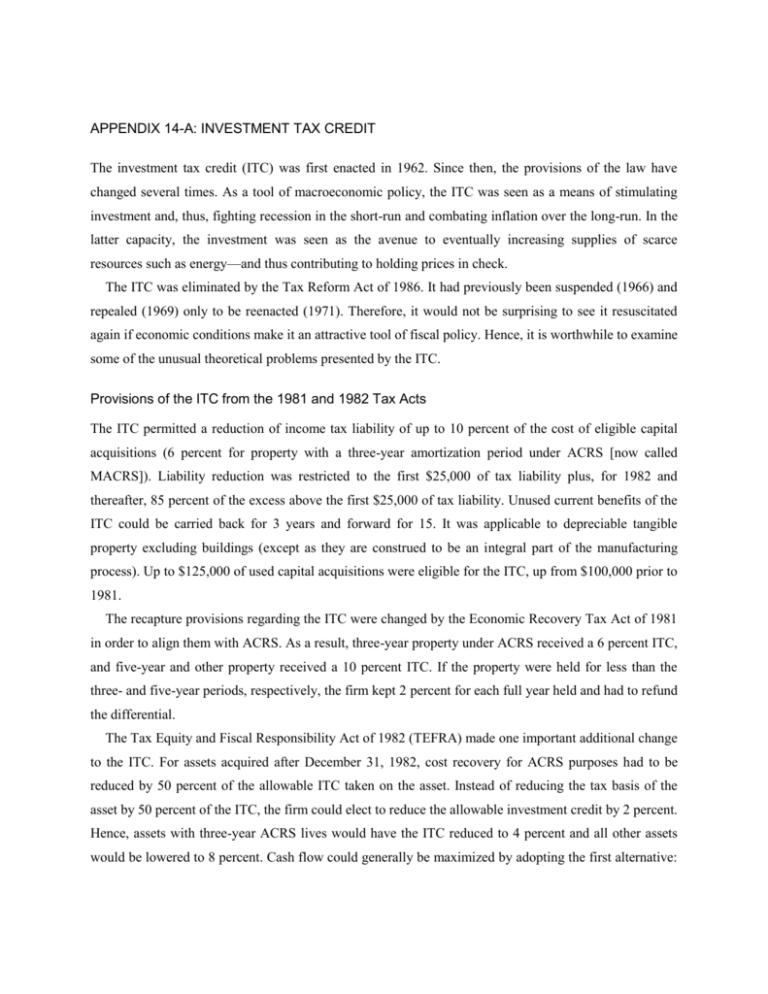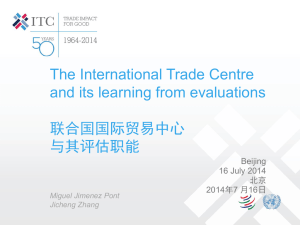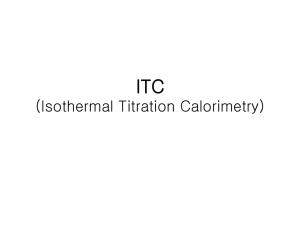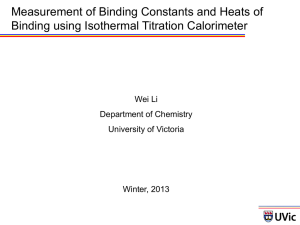APPENDIX 14 A: INVESTMENT TAX CREDIT
advertisement

APPENDIX 14-A: INVESTMENT TAX CREDIT The investment tax credit (ITC) was first enacted in 1962. Since then, the provisions of the law have changed several times. As a tool of macroeconomic policy, the ITC was seen as a means of stimulating investment and, thus, fighting recession in the short-run and combating inflation over the long-run. In the latter capacity, the investment was seen as the avenue to eventually increasing supplies of scarce resources such as energy—and thus contributing to holding prices in check. The ITC was eliminated by the Tax Reform Act of 1986. It had previously been suspended (1966) and repealed (1969) only to be reenacted (1971). Therefore, it would not be surprising to see it resuscitated again if economic conditions make it an attractive tool of fiscal policy. Hence, it is worthwhile to examine some of the unusual theoretical problems presented by the ITC. Provisions of the ITC from the 1981 and 1982 Tax Acts The ITC permitted a reduction of income tax liability of up to 10 percent of the cost of eligible capital acquisitions (6 percent for property with a three-year amortization period under ACRS [now called MACRS]). Liability reduction was restricted to the first $25,000 of tax liability plus, for 1982 and thereafter, 85 percent of the excess above the first $25,000 of tax liability. Unused current benefits of the ITC could be carried back for 3 years and forward for 15. It was applicable to depreciable tangible property excluding buildings (except as they are construed to be an integral part of the manufacturing process). Up to $125,000 of used capital acquisitions were eligible for the ITC, up from $100,000 prior to 1981. The recapture provisions regarding the ITC were changed by the Economic Recovery Tax Act of 1981 in order to align them with ACRS. As a result, three-year property under ACRS received a 6 percent ITC, and five-year and other property received a 10 percent ITC. If the property were held for less than the three- and five-year periods, respectively, the firm kept 2 percent for each full year held and had to refund the differential. The Tax Equity and Fiscal Responsibility Act of 1982 (TEFRA) made one important additional change to the ITC. For assets acquired after December 31, 1982, cost recovery for ACRS purposes had to be reduced by 50 percent of the allowable ITC taken on the asset. Instead of reducing the tax basis of the asset by 50 percent of the ITC, the firm could elect to reduce the allowable investment credit by 2 percent. Hence, assets with three-year ACRS lives would have the ITC reduced to 4 percent and all other assets would be lowered to 8 percent. Cash flow could generally be maximized by adopting the first alternative: taking the maximum allowable ITC. As will be seen shortly, this presents some thorny conceptual problems. Interpreting the ITC The fiasco APB Opinion Nos. 2 and 4 caused in choosing an appropriate accounting for the ITC has already been discussed in Chapter 3. There have been at least four interpretations of the transaction: 1. Reduction of the cost of the asset. 2. Allocation by means of a deferred investment credit account. 3. Capital donated by the government. 4. Flow through (immediate recognition of all benefits taken in the year of acquisition). The first two methods are allocations, while the last two are not. Reduction of Asset Cost The apparent intention of the government concerning the ITC was to reduce the cost of capital acquisitions, which, in turn, because it increases the internal rate of return or net present value of potential capital acquisitions, stimulates investment in new plant and equipment. Therefore, a possible treatment is to leave tax expense unaffected by the ITC and reduce the cost of the affected assets by these amounts. The method is somewhat analogous to the net-of-tax approach to income tax allocation. The method would result in the benefits being taken over the lives of eligible assets in the form of lower depreciation. Of course, depreciation expense under historical cost is an allocation, and the effect of the ITC reduction in terms of user relevance is not clear. Under current value approaches in situations in which depreciation is theoretically equal to the change in the market value of the asset between the beginning and end of the period, the ITC reduction to cost would not apply. Acceptance or rejection of the asset reduction approach largely hinges on the definition of cost. Indeed, SFAC No. 3 has interpreted the ITC as an asset reduction. Let us examine what this interpretation implies in terms of the meaning of cost. It has linked together two totally separate transactions: (1) the net cash cost of the asset and (2) the amount of the ITC that is attributable to the particular asset. Although there are numerous other examples linking somewhat separate transactions—interest during construction of buildings in SFAS No. 34, for example—no other linkage is as “wide” as this one. The cost of the asset is literally dependent upon the firm’s making a profit in order for income taxes to be reduced by the ITC. A similar problem occurs in the event of an ITC carryforward because the assignment of the ITC taken during the current year to particular assets is arbitrary (another allocation problem). However, if an allocation solution is desired, the balance sheet treatment of the credits as asset reductions does appear to be superior to the deferred investment credit method. Deferred Investment Credit This allocation method sets up a deferred investment credit account and writes it off over the life of affected assets by means of reducing (crediting) income tax expense. This account is neither a liability nor an owner’s equity account. It is another example of a deferred-credit class of account. However, it differs from deferred tax credits arising under income tax allocation. Deferred credits per se are ruled out by SFAC No. 3. In the case of tax allocation, the deferred credit can be interpreted as a liability (the rollover view). The deferred credit under the ITC, however, has only a contingent liability aspect which arises because of the ITC recapture provision if the asset is disposed of prior to the full five-year (or three-year) holding period. Although the income result is the same as under the asset reduction method—assuming the amortization methods are the same—the deferred credit nature of the balance sheet account makes it much less desirable than that method. Donated Capital View The donated capital view would be implemented by setting income tax expense at the amount it would have been without the investment credit and with an offset to donated capital. As with the “new form of equities” interpretation of income tax allocation, the argument has some plausibility but it is not really convincing. Macroeconomic policy that results in tax reduction does not persuasively lead to the conclusion that this is, in effect, an investment in the firm by the government. Flow Through A reasonable case can at least be made for flow through of ITC benefits. The strongest argument against it is that the benefits should be associated with usage rather than purchase. This is, of course, the matching argument, which underlies the reduction-of-asset-cost and deferred-investment-credit methods—which unfortunately leads to allocation problems and some questionable definitions. Although the government’s intention may have been to reduce capital investment costs, it accomplished this by means of tax reduction, and the flow-through interpretation reflects exactly that. Non-flow-through treatment leads to allocation problems. Assuming efficient markets, it is simply not clear whether these methods provide additional information in the form, for example, of better cash flow predictions. In the absence of this evidence, flow through has the advantage of being less costly than the allocation methods, and its benefits in terms of user relevance appear to be at least on a par with those methods. Accounting for the ITC The provision in TEFRA for reducing an asset’s tax base by one-half of the ITC taken leads to some serious results. Assume that the ITC on an asset costing $100,000 is taken in full in the year of acquisition. For financial statement purposes, the asset has a 10-year life and no salvage value. Straight-line depreciation is to be employed. The asset will be written off over 5 years by means of MACRS for tax purposes. Financial depreciation and the application of MACRS are shown in Exhibit 14-9. EXHIBIT 14-9 ACRS and Financial Depreciation with Different Lives a b c d e Straight-line Depreciation Year ACRS 1 2 3 4 5 6 7 8 9 10 $19,000a 30,400b 18,240c 10,944d 10,944d 5,472e $ 10,000 10,000 10,000 10,000 10,000 10,000 10,000 10,000 10,000 10,000 $95,000 $ 100,000 20% × $95,000 32% × $95,000 19.2% × $95,000 11.52% × $95,000 5.76% × $95,000 Notice that there is both a timing difference and a permanent difference in the expense amounts shown in Exhibit 14-9. Technically speaking, we are faced with an allocation problem. However, this problem can be most simply handled, given comprehensive income tax allocation, by recognizing for income tax allocation purposes the timing differences first and not recognizing the permanent difference until the tenth year. Recognition of the permanent difference first, however, may obviate any need to allocate income taxes. This may be a pleasing prospect because of the swollen size of the deferred tax credit account on the books of many American corporations. Because it decreases the tax base of the asset by one-half of the ITC taken in the year of acquisition, TEFRA has led to even more basic problems for accounting for the ITC. If flow through is used, should the reduction of the tax expense be for the gross amount of the tax reduction? Or should this tax expense be reduced by the amount of the depreciation shield lost as a result of the lowering of the tax base? The latter may be more useful in terms of indicating future cash flows but cannot be accomplished without using accruals; hence, it is a modified cash flow approach to the problem. If accrual (deferral) of ITC benefits is desired, three possibilities present themselves: (1) credit of the entire liability deduction to a deferred investment credit account, (2) reduction of the fixed asset by the entire liability deduction, and (3) splitting of the liability deduction between the fixed asset and a deferred credit account. None of these solutions is entirely acceptable. The deferred investment credit account does not qualify as a liability, a revenue, or a gain under SFAC No. 6. If the entire credit is to the fixed-asset account, then book and tax bases of assets will differ, as will depreciable lives and depreciation methods. Nevertheless, it still appears to be the most palatable of the deferral approaches. Theory has thus far provided us with no definitive criteria for unraveling the ITC problem. The definitional screen for both deferred investment credits and deferred tax credits in SFAC No. 3 is a useful first step for coping with the dilemma. The broader context of relevance to users is thus far largely unexamined. Whether research can provide insights to the question of user relevance appears to be very doubtful at this time. The Present State of ITC Accounting As a result of the politics of the ITC, either allocation or flow through has been allowable, or even a combination of the two (as a result of the complexities brought about by TEFRA). There does not appear to be a relevant circumstance that differentiates among investment credit transactions. Hence, the ITC would appear to be a viable candidate for rigid uniformity treatment. A reasonable choice, as previously discussed, would be flow through. Of course, that would present an interesting situation of two problems having some similar facets—income tax allocation and the ITC—handled on two entirely different bases.









